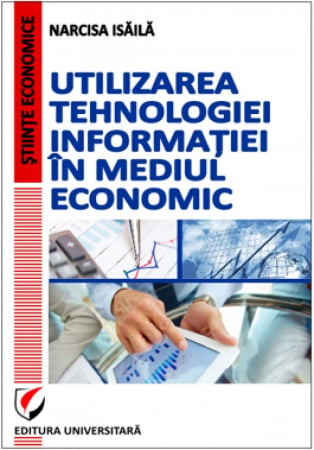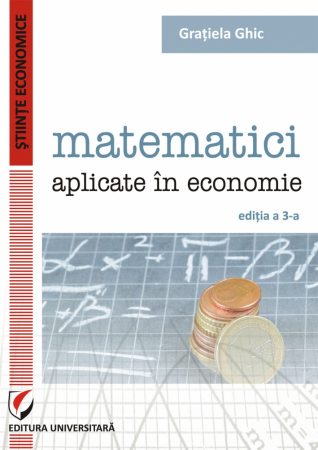ISBN: 978-606-28-0655-2
DOI: 10.5682/9786062806552
Publisher year: 2017
Edition: V
Pages: 566
Publisher: Editura Universitară
Author: Victor Munteanu - Coordonator
- Description
- Download (1)
- Authors
- Content
- More details
- Reviews (0)
"Financial accounting of the enterprise" deals essentially with the study of the principles of financial accounting, its working methods and techniques, both theoretically and practically, applied. His methodological-didactic approach aims to offer those interested the most efficient ways to understand and deepen all accounting problems, to form a logical, independent accounting thinking and the skills necessary for "production" and use of accounting information in the management of of the enterprise.
Accounting issues - addressed in the paper, is opposable to economic entities, each chapter highlighting the objectives and factors of material and formal organization of accounting in a given field.
From the accounting issues of the company was chosen and presented the organization and normalization of financial accounting, capital accounting, fixed assets, current assets, settlements with third parties, treasury, revenues and expenses, off-balance sheet items of economic entities, about the year end financial and accounting reporting, as well as about the accounting of other economic operations.
In the content of the paper are integrated the significant elements, in the field of accounting, of the European directives and International Financial Reporting Standards (IFRS), as well as of Order No. 1802 / December2014 of the Minister of Public Finance for approving the accounting regulations on individual annual financial statements and financial statements consolidated annual accounts.
Related to the university need and the accounting profession, the book offers the theoretical, methodological foundations and practical references regarding the financial accounting in Romania, in the conditions of the integration of the recent accounting regulations and of the International Financial Reporting Standards.
The paper is addressed, first of all, to those who, in high schools, faculties or other forms of professional training, study accounting.
It is intended, secondly, for accounting practitioners, accountants, economists, accounting experts, financial auditors, financial analysts and other specialists who want to deepen the informational value of accounting.All of them are offered the issue of organization, management and accounting technique in terms of Romanian standardization and application, based on the normative acts in the field developed in our country.
-
Financial Accounting of the Enterprise
Download
FOREWORD / 15
CHAPTER 1: THE BASICS OF ORGANIZING FINANCIAL ACCOUNTING / 17
1.1. Definition of financial accounting / 17
1.2. Elements regarding the normalization and regulation of financial accounting / 18
1.2.1. Definition, types and concepts of accounting normalization / 18
1.2.2. Accounting standardization devices in Romania / 19
1.2.2.1. Accounting law no. 82/1991, republished / 20
1.2.2.2. Accounting regulations regarding the individual annual financial statements and the consolidated annual financial statements (Order M.F.P. no. 1802 / December 2014) / 20
1.2.3. IASB general conceptual framework. Definition, purpose and scope / 21
1.2.3.1. Define, purpose / 21
1.2.3.2. Scope / 22
1.3. Objective of financial statements (reporting) / 23
1.4. Qualitative characteristics of financial information and accurate image / 25
1.4.1. Qualitative characteristics / 25
1.4.2. The real and correct image. The faithful image / 27
1.5. Users of financial statements / 28
1.6. Defining, recognizing and evaluating the structures in the financial statements / 29
1.6.1. Elements (structures) modeled by financial statements. Delimitations and definitions / 29
1.6.2. Recognition of structures in financial statements / 30
1.6.3. Evaluation of elements (structures) in the financial statements / 31
1.6.3.1. Basics of evaluation in accounting / 31
1.6.3.2. Valuation rules as a reference system in the formulation of accounting policies / 34
1.7. The concept of capital and capital maintenance / 38
1.8. Principles of financial accounting / 39
1.9. Financial statements (reports) - delimitations and references / 41
1.9.1. Financial statements (reports) within the meaning of IFRS / 42
1.9.1.1. Balance sheet / 43
1.9.1.2. Profit and loss account / 43
1.9.1.3. Statement of changes in equity / 45
1.9.1.4. Cash flow statement / 45
1.9.1.5. Explanatory notes / 48
1.9.2. Financial statements / annual accounts in accordance with the Fourth Directive of the European Economic Communities / 49
1.9.2.1. Balance sheet / 49
1.9.2.2. Profit and loss account / 54
1.9.2.3. The annex to the balance sheet or the notes to the accounts according to the 4th Directive of the C.E.E. / 55
1.9.3. Regulated financial statements in Romanian accounting / 56
1.9.3.1. Balance sheet - the statement of the financial position of the entity / 57
1.9.3.2. Profit and loss account - the financial performance of the entity / 59
1.9.3.3. Statement of changes in equity / 61
1.9.3.4. Cash flow statement / 62
1.9.3.5. Explanatory notes to the annual financial statements / 65
CHAPTER 2: CAPITAL ACCOUNTING / 68
2.1. Content and structure of capitals / 68
2.2. Organization of capital accounting / 69
2.2.1. Objectives and factors of capital accounting organization / 69
2.2.2. Organization of the system of documents and of the operative evidence of the capitals 70 2.2.3. Current capital valuation / 72
2.2.4. The system of accounts used in the organization of capital accounting / 76
2.3. Accounting for equity operations / 77
2.3.1. Share capital accounting / 77
2.3.1.1. Accounting of the operations of constitution of the social capital / 78
2.3.1.2. Accounting for operations regarding the increase of the share capital / 83
2.3.1.3. Accounting for operations regarding the decrease of the share capital / 86
2.3.2. Accounting for capital premiums / 91
2.3.3. Revaluation reserve accounting / 97
2.3.4. Accounting for legal reserves and other reserves / 98
2.3.5. Own shares accounting / 100
2.3.6. Accounting for results / 101
2.3.6.1. Accounting for the carried forward result / 101
2.3.6.2. Accounting for the result of the exercise / 103
2.3.7. Accounting for gains or losses related to the issue, redemption, sale, assignment free of charge or cancellation of equity instruments / 105
2.4. Accounting for provisions / 106
2.4.1. Accounting for litigation provisions / 107
2.4.2. Accounting for provisions for guarantees granted to customers / 108
2.4.3. Accounting for provisions for decommissioning of fixed assets and other similar actions related to them / 110
2.4.4. Accounting for restructuring provisions / 111
2.4.5. Accounting for provisions for pensions and similar obligations / 113
2.4.6. Accounting for tax provisions / 113
2.4.7. Accounting for provisions for terminating the employment contract / 113
2.4.8. Accounting for other provisions / 113
2.4.9. Evaluation of provisions / 114
2.5. Accounting for loans and similar debts / 115
2.5.1. Accounting for loans from bond issues / 115
2.5.2. Accounting for long - term bank loans / 118
2.5.3. Accounting for other loans and similar liabilities / 121
CHAPTER 3: ACCOUNTING OF FIXED ASSETS / 125
3.1. Delimitations and structures regarding fixed assets / 125
3.2. Organization of fixed assets accounting / 127
3.2.1. Objectives and factors of organizing the accounting of fixed assets / 127
3.2.2. Primary documents regarding fixed assets / 127
3.2.3. Fixed assets accounts subsystem / 130
3.2.4. Valuation of fixed assets / 130
3.3. Accounting for intangible assets / 133
3.3.1. Characterization of intangible assets; recognition and evaluation / 133
3.3.2. Establishment expense accounting / 134
3.3.3. Development expenditure accounting / 136
3.3.4. Accounting for fixed assets in concessions, patents, licenses, trademarks, rights and similar assets / 140
3.3.5. Goodwill accounting / 145
3.3.6. Accounting for other intangible assets / 148
3.4. Accounting for property, plant and equipment / 149
3.4.1. Land and land planning accounting / 150
3.4.1.1. Land accounting proper / 150
3.4.1.2. Landscaping accounting / 152
3.4.2. Fixed assets accounting / 154
3.4.2.1. Delimitations and structures regarding fixed assets / 154
3.4.2.2. Organization of fixed assets accounting / 156
3.4.2.3. Fixed assets movement accounting / 163
A. Accounting for transactions regarding fixed assets inflows / 163
B. Accounting for transactions regarding fixed assets outflows / 174
C. Accounting for leased fixed assets / 185
3.5. Real estate investment accounting / 186
3.6. Accounting for productive biological assets / 187
3.7. Accounting for fixed assets under construction / 188
3.7.1. General characterization of assets under construction / 188
3.7.2. Accounting for tangible fixed assets in progress / 189
3.8. Accounting for financial assets / 189
3.8.1. Definitions and structures regarding financial assets / 189
3.8.2. Recognition and evaluation of financial assets / 191
3.8.3. Accounting of transactions regarding financial assets in securities / 191
3.9. Depreciation accounting for fixed assets / 196
3.9.1. Depreciation of fixed assets / 196
3.9.1.1. Definition, role and calculation methods regarding depreciation / 196
3.9.1.2. Depreciation accounting / 207
3.9.2. Accounting for adjustments for depreciation or impairment of fixed assets / 209
3.9.2.1. General characterization of adjustments for depreciation of fixed assets / 209
3.9.2.2. Accounting for adjustments for impairment of intangible assets / 211
3.9.2.3. Accounting for adjustments for impairment of property, plant and equipment / 211
3.9.2.4. Accounting for adjustments for impairment of financial assets / 211
3.9.2.5. Accounting for adjustments for depreciation of fixed assets in progress / 212
CHAPTER 4: ACCOUNTING OF CURRENT ASSETS / 214
4.1. Definitions and delimitations regarding current assets / 214
4.2. Inventory accounting / 215
4.2.1. Definition and recognition of stocks / 215
4.2.2. Objectives and factors of stock accounting organization / 218
4.2.3. Stock valuation / 219
4.3. Organization of the information-accounting system of stocks / 230
4.4. Organization of analytical accounting of stocks / 235
4.5. Organizing synthetic stock accounting / 240
4.6. Accounting of raw materials and consumables / 244
4.7. Production accounting in progress / 258
4.8. Product accounting / 261
4.8.1. Product accounting organization / 261
4.8.2. Semi - finished products accounting / 263
4.8.3. Accounting for finished products / 267
4.8.4. Accounting for residual products / 271
4.9. Accounting for stocks held by third parties / 271
4.10. Accounting for biological assets of the nature of stocks / 274
4.11. Commodity accounting / 277
4.12. Accounting for packaging stocks / 285
4.12.1. The notion and classification of packaging / 285
4.12.2. Packaging accounting organization / 287
4.12.3. Accounting of the main operations regarding the packaging / 290
4.13. Accounting for adjustments for depreciation of inventories and production in progress / 297
CHAPTER 5: ACCOUNTING OF THIRD PARTY SETTLEMENTS / 305
5.1. Definition, content and structure of settlements with third parties / 305
5.2. Objectives and factors of organizing the settlement accounting with third parties / 308
5.3. Recognition and valuation of debts and receivables / 309
5.4. Information-accounting system of debts and receivables / 310
5.4.1. Primary documents used / 310
5.4.2. Operative evidence of debts and receivables / 311
5.4.3. Analytical accounting of debts and receivables / 311
5.4.4. The system of synthetic accounts used to reflect in accounting the settlements with third parties / 311
5.5. Accounting transactions regarding settlements with suppliers / 312
5.6. Accounting transactions regarding settlements with customers / 324
5.7. Accounting for settlements with staff and assimilated operations / 334
5.8. Accounting for settlements with social insurances and social protection / 348
5.9. Accounting for settlements with the state budget and special funds / 354
5.9.1. Profit tax settlements / 354
5.9.2. Value added tax settlements / 357
5.9.2.1. Value added tax - definition, scope, generating fact, base and tax rates, settlement / 357
5.9.2.2. Objectives and factors of organizing the accounting of value added tax / 363
5.9.2.3. Organization of value added tax accounting / 364
5.9.2.4. Subsystem of value added tax accounts / 369
5.9.2.5. Applications regarding the accounting of value added tax settlement operations / 376
5.9.2.6. Value added tax settlement / 382
5.9.3. Subsidy settlements / 384
5.9.4. Settlements regarding other taxes, fees and assimilated payments / 385
5.9.5. Accounting for settlements with special funds / 386
5.9.6. Other debts and receivables with the state budget / 388
5.10. Accounting / operations regarding the settlements within the group with shareholders / associates / 389
5.11. Settlement accounting with various debtors and creditors / 390
5.11.1. Settlements with various debtors / 390
5.11.2. Settlements with various creditors / 393
5.12. Accounting of operations regarding the accounts of subsidies, regularization and assimilated. 394
5.12.1. Expenses recorded in advance / 394
5.12.2. Revenues recorded in advance / 397
5.12.3. Settlements from operations under clarification / 398
5.12.4. Investment grants / 399
5.13. Accounting for adjustments for impairment of receivables / 401
CHAPTER 6: TREASURY ACCOUNTING / 404
6.1. Delimitations and accounting structures regarding the entity's treasury / 404
6.2. Organization of treasury accounting / 405
6.3. Short - term investment accounting / 409
6.3.1. Characteristics and structure of short - term investments / 409
6.3.2. Short - term investment evaluation / 411
6.3.3. Accounting for shares held in affiliated entities / 412
6.3.4. Accounting for short-term investments in bonds / 413
6.3.5. Accounting for green certificates / 418
6.3.6. Accounting for other short - term investments and similar receivables / 419
6.4. Accounting for receivables / 420
6.4.1. Checks receivable / 420
6.4.2. Cash effects / 421
6.4.3. Effects remitted for discounting / 422
6.5. Accounting of collection and payment operations performed through bank accounts / 422
6.5.1. Bank accounts in lei / 422
6.5.2. Bank accounts in foreign currency / 426
6.5.3. Amounts being settled / 429
6.6. Accounting for short - term bank loans / 430
6.7. Interest accounting on cash and short-term bank loans / 431
6.8. Accounting for cash operations and other treasury values / 433
6.8.1. Accounting for cash operations / 433
6.9. Accounting for letters of credit and cash advances / 437
6.9.1. Letters of credit / 437
6.9.2. Treasury advances / 438
6.10. Peculiarities regarding the accounting of internal transfers / 440
6.11. Accounting for adjustments for impairment of treasury accounts / 442
CHAPTER 7: FINANCIAL ACCOUNTING OF EXPENDITURE, REVENUE AND INCOME / 445
A. FINANCIAL ACCOUNTING OF EXPENDITURE / 445
7.1. The concept, content, recognition and structure of expenditure / 445
7.2. Objectives and factors of organizing the accounting of expenses / 447
7.2.1. Organization of primary documentation / 448
7.2.2. Organization of synthetic accounting of expenses / 448
7.3. Accounting for operating expenses / 451
7.3.1. Inventory accounting for stocks / 451
7.3.1.1. Expenditures on raw materials / 451
7.3.1.2. Expenditures on consumables / 452
7.3.1.3. Expenditures on materials of the nature of inventory items / 453
7.3.1.4. Expenditure on non - stored materials / 454
7.3.1.5. Energy and water expenditure / 454
7.3.1.6. Expenditures on biological assets of the nature of stocks / 455
7.3.1.7. Expenditure on goods / 455
7.3.1.8. Expenditure on packaging / 456
7.3.2. Accounting for expenses with services performed by third parties / 457
7.3.2.1. Maintenance and repair expenses / 457
7.3.2.2. Expenses with royalties, management locations and rents / 458
7.3.2.3. Expenses with insurance premiums / 459
7.3.2.4. Expenditures on studies and research / 460
7.3.3. Accounting for expenses with other services performed by third parties / 460
7.3.3.1. Expenditures with collaborators / 460
7.3.3.2. Expenses regarding commissions and fees / 461
7.3.3.3. Protocol, advertising and publicity expenses / 461
7.3.3.4. Expenditure on transport of goods and personnel / 462
7.3.3.5. Travel, secondment and transfer expenses / 463
7.3.3.6. Postal charges and telecommunications charges / 464
7.3.3.7. Expenditures on banking and similar services / 465
7.3.3.8. Other expenses with services performed by third parties / 465
7.3.4. Accounting for expenses with taxes, fees and assimilated payments / 466
7.3.4.1. Expenditures with other taxes, fees and assimilated payments / 466
7.3.5. Personnel expense accounting / 468
7.3.5.1. Staff salaries / 468
7.3.5.2. Expenditures on insurance and social protection / 469
7.3.6. Accounting for other operating expenses / 470
7.3.6.1. Accounting for environmental protection expenses / 470
7.3.6.2. Accounting for losses from miscellaneous receivables and payables / 471
7.3.6.3. Expenses from revaluation of tangible fixed assets / 471
7.3.6.4. Other operating expenses
7.3.7. Accounting / expenses / for / operating / depreciation, provisions and adjustments for impairment or impairment / 472
7.4. Accounting for expenses from financial activity / 473
7.4.1. Expenditures on losses from receivables related to participations / 473
7.4.2. Expenditures on assigned financial investments / 474
7.4.3. Expenses from exchange rate differences / 475
7.4.4. Interest expenses / 475
7.4.5. Expenditures on discounts granted / 476
7.4.6. Financial expenses regarding depreciation, provisions and adjustments for impairment / 476
7.4.7. Other financial expenses / 477
7.5. Accounting for income tax expenses / 477
7.6. Expenditure settlement accounting / 478
B. FINANCIAL ACCOUNTING OF REVENUE / 479
7.7. The concept, content, recognition and structure of income / 479
7.8. Objectives and factors of income accounting organization / 482
7.9. Organization of financial accounting of income / 483
7.9.1. Organization of primary documentation / 483
7.9.2. Organization of synthetic income accounting / 484
7.10. Accounting for operating income / 484
7.10.1. Sales revenue accounting (net turnover) / 484
7.10.1.1. Revenues from the sale of finished products, agricultural products and biological assets in the nature of stocks. / 484
7.10.1.2. Revenues from the sale of semi - finished products / 485
7.10.1.3. Revenues from the sale of residual products / 486
7.10.1.4. Revenue from services rendered / 487
7.10.1.5. Revenues from studies and research / 487
7.10.1.6. Revenues from royalties, management locations and rents / 488
7.10.1.7. Revenue from the sale of goods / 488
7.10.1.8. Revenues from various activities / 489
7.10.2. Revenue accounting for product inventory costs / 489
7.10.3. Accounting of income from the production of fixed assets / 495
7.10.3.1. Revenues from the production of intangible assets / 496
7.10.3.2. Revenues from the production of tangible assets / 496
7.10.3.3. Income from real estate investment production / 497
7.10.4. Accounting for operating subsidies / 497
7.10.5. Accounting for other operating income / 498
7.10.5.1. Revenues from reactivated receivables and miscellaneous debtors / 498
7.10.5.2. Revenues from the revaluation of tangible fixed assets / 498
7.10.5.3. Other operating income / 499
7.10.6. Accounting for income from provisions, depreciation and adjustment for impairment or impairment of operating activity / 499
7.11. Accounting for income from financial activity / 500
7.11.1. Income from financial fixed assets / 501
7.11.2. Income from other short - term investments / 501
7.11.3. Income from assigned financial investments / 501
7.11.4. Income from exchange rate differences / 502
7.11.5. Interest income / 503
7.11.6. Revenues from discounts obtained / 504
7.11.7. Other financial income / 504
7.11.8. Financial income from depreciation and amortization 505
7.12. Revenue settlement accounting / 506
C. ACCOUNTING OF THE RESULT OF THE YEAR / 506
7.13. Determination of the result / 506
7.14. Reflection in accounting of the determination of the financial result / 507
7.15. Calculation, registration and settlement of profit tax / 510
7.16. Accounting for the distribution of the result of the exercise / 515
CHAPTER 8: ACCOUNTING FOR OTHER VALUES OUTSIDE THE BALANCE SHEET 519
8.1. General characterization of special accounts / 519
8.2. Off - balance sheet accounts / 520
8.2.1. Commitments granted / 520
8.2.2. Commitments received / 520
8.2.3. Other off - balance sheet accounts / 521
8.2.3.1. Tangible fixed assets received on rent or on the basis of other similar contracts / 521
8.2.3.2. Material values received for processing or repair / 521
8.2.3.3. Material values received in storage or custody / 522
8.2.3.4. Debtors removed from assets, follow further / 522
8.2.3.5. Stocks of the nature of inventory objects put into use / 522
8.2.3.6. Royalties, management locations, rents and other similar debts / 523
8.2.3.7. Expected effects not due / 523
8.2.3.8. Goods received in administration, concession and rent / 523
8.2.3.9. Other off-balance sheet values / 523
8.2.4. Interest related to leasing contracts and other assimilated contracts, not due / 524
8.2.5. Greenhouse gas emission certificates / 524
8.2.6. Contingent assets / 524
8.2.7. Contingent liabilities / 525
8.2.8. Receivables taken over by assignment / 526
8.3. Balance sheet accounts / 526
8.3.1. Opening balance sheet / 526
8.3.2. Closing balance sheet / 527
CHAPTER 9: CLOSING WORKS FOR THE FINANCIAL YEAR / 528
9.1. Delimitations regarding the closing works of the financial year / 528
9.2. Preparatory works for the preparation of financial statements / 529
9.2.1. Establishing the balance of accounts before inventory / 530
9.2.2. General inventory of assets and liabilities / 531
9.2.3. Accounting for regularization operations / 534
a. Operations regarding the regularization of inventory pluses and minuses / 534
b. Depreciation operations / 536
c. Impairment and impairment adjustments / 537
d. Operations regarding the resumption of provisions / 539
e. Operations regarding exchange rate differences / 539
f. Operations regarding the time delimitation of expenses and revenues. / 540
9.2.4. Balance of accounts by inventory / 541
9.2.5. Determining the result of the exercise / 543
9.2.6. Drafting financial statements / 545
A. Balance / 546
B. Profit and loss account / 549
C. Statement of changes in equity / 560
D. Statement of cash flows / 561
E. Explanatory notes / 561
BIBLIOGRAPHY / 563
"Financial accounting of the enterprise" deals essentially with the study of the principles of financial accounting, its working methods and techniques, both theoretically and practically, applied. His methodological-didactic approach aims to offer those interested the most efficient ways to understand and deepen all accounting problems, to form a logical, independent accounting thinking and the skills necessary for "production" and use of accounting information in the management of of the enterprise.
Accounting issues - addressed in the paper, is opposable to economic entities, each chapter highlighting the objectives and factors of material and formal organization of accounting in a given field.
From the accounting issues of the company was chosen and presented the organization and normalization of financial accounting, capital accounting, fixed assets, current assets, settlements with third parties, treasury, revenues and expenses, off-balance sheet items of economic entities, about the year end financial and accounting reporting, as well as about the accounting of other economic operations.
In the content of the paper are integrated the significant elements, in the field of accounting, of the European directives and International Financial Reporting Standards (IFRS), as well as of Order No. 1802 / December2014 of the Minister of Public Finance for approving the accounting regulations on individual annual financial statements and financial statements consolidated annual accounts.
Related to the university need and the accounting profession, the book offers the theoretical, methodological foundations and practical references regarding the financial accounting in Romania, in the conditions of the integration of the recent accounting regulations and of the International Financial Reporting Standards.
The paper is addressed, first of all, to those who, in high schools, faculties or other forms of professional training, study accounting.
It is intended, secondly, for accounting practitioners, accountants, economists, accounting experts, financial auditors, financial analysts and other specialists who want to deepen the informational value of accounting.All of them are offered the issue of organization, management and accounting technique in terms of Romanian standardization and application, based on the normative acts in the field developed in our country.
When writing the paper we used a rich foreign legislation and literature, but especially local. We thank the Romanian normalizers for their efforts to create and then perfect a competitive accounting system.
We also appreciate the interest and professional competence of specialists in education, research and practice in the field of accounting for books, studies and our own points of view that have seen the light of day and that have been of real use in writing the paper. We enjoyed the qualified support of the publishing house, the printing house, the editor and the word processors, who took care of the operative preparation and the appearance in the best conditions of the work, for which we thank them.
We thank, a priori, our readers, pupils and students, teachers, specialists who will have the patience and interest to read and use this book.
We are aware that this paper can be improved, that it can be the subject of critical reflections, suggestions and proposals. Therefore, we will be grateful to all for the submitted recommendations that we are waiting for with due attention and that we will receive with pleasure and distinguished consideration and we will consider them in a possible new edition.
Bucharest, October 2017
The Authors

6359.png)
![Financial Accounting of the Enterprise - Victor Munteanu - Coordonator [1] Financial Accounting of the Enterprise - Victor Munteanu - Coordonator [1]](https://gomagcdn.ro/domains/editurauniversitara.ro/files/product/large/contabilitatea-financiara-a-intreprinderii-373-843831.jpg)














